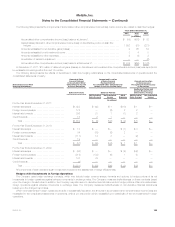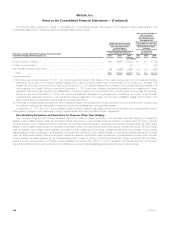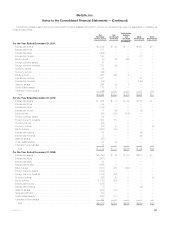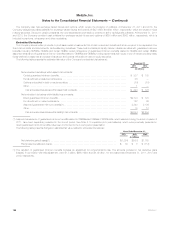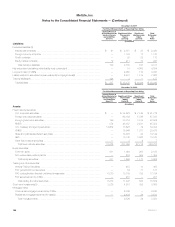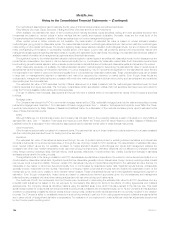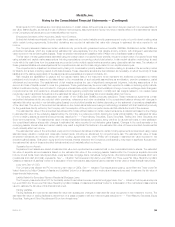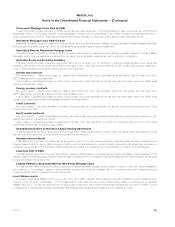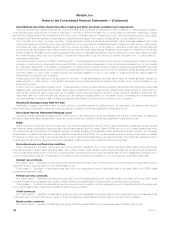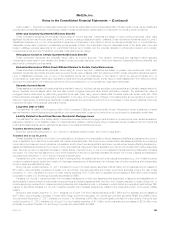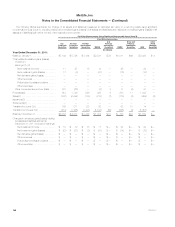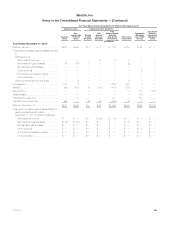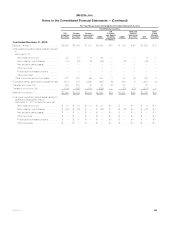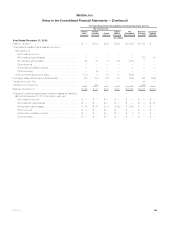MetLife 2011 Annual Report Download - page 159
Download and view the complete annual report
Please find page 159 of the 2011 MetLife annual report below. You can navigate through the pages in the report by either clicking on the pages listed below, or by using the keyword search tool below to find specific information within the annual report.MetLife, Inc.
Notes to the Consolidated Financial Statements — (Continued)
Most inputs for OTC derivatives are mid market inputs but, in certain cases, bid level inputs are used when they are deemed more representative of
exit value. Market liquidity, as well as the use of different methodologies, assumptions and inputs, may have a material effect on the estimated fair values
of the Company’s derivatives and could materially affect net income.
Embedded Derivatives Within Asset and Liability Host Contracts
Embedded derivatives principally include certain direct, assumed and ceded variable annuity guarantees and equity or bond indexed crediting rates
within certain funding agreements. Embedded derivatives are recorded at estimated fair value with changes in estimated fair value reported in net
income.
The Company issues and assumes certain variable annuity products with guaranteed minimum benefits. GMWBs, GMABs and certain GMIBs are
embedded derivatives, which are measured at estimated fair value separately from the host variable annuity contract, with changes in estimated fair
value reported in net derivative gains (losses). These embedded derivatives are classified within PABs in the consolidated balance sheets.
The fair value of these guarantees is estimated using the present value of projected future benefits minus the present value of projected future fees
using actuarial and capital market assumptions including expectations concerning policyholder behavior. A risk neutral valuation methodology is used
under which the cash flows from the guarantees are projected under multiple capital market scenarios using observable risk free rates. The valuation of
these guarantee liabilities includes adjustments for nonperformance risk and for a risk margin related to non-capital market inputs.
The nonperformance adjustment is determined by taking into consideration publicly available information relating to spreads in the secondary market
for MetLife, Inc.’s debt, including related credit default swaps. These observable spreads are then adjusted, as necessary, to reflect the priority of these
liabilities and the claims paying ability of the issuing insurance subsidiaries compared to MetLife, Inc.
Risk margins are established to capture the non-capital market risks of the instrument which represent the additional compensation a market
participant would require to assume the risks related to the uncertainties of such actuarial assumptions as annuitization, premium persistency, partial
withdrawal and surrenders. The establishment of risk margins requires the use of significant management judgment, including assumptions of the
amount and cost of capital needed to cover the guarantees. These guarantees may be more costly than expected in volatile or declining equity markets.
Market conditions including, but not limited to, changes in interest rates, equity indices, market volatility and foreign currency exchange rates; changes in
nonperformance risk; and variations in actuarial assumptions regarding policyholder behavior, mortality and risk margins related to non-capital market
inputs may result in significant fluctuations in the estimated fair value of the guarantees that could materially affect net income.
The Company ceded the risk associated with certain of the GMIBs and GMABs previously described. These reinsurance agreements contain
embedded derivatives which are included within premiums, reinsurance and other receivables in the consolidated balance sheets with changes in
estimated fair value reported in net derivative gains (losses) or policyholder benefits and claims depending on the statement of operations classification
of the direct risk. The value of the embedded derivatives on the ceded risk is determined using a methodology consistent with that described previously
for the guarantees directly written by the Company with the exception of the input for nonperformance risk that reflects the credit of the reinsurer.
The estimated fair value of the embedded derivatives within funds withheld related to certain ceded reinsurance is determined based on the change
in estimated fair value of the underlying assets held by the Company in a reference portfolio backing the funds withheld liability. The estimated fair value
of the underlying assets is determined as previously described in “— Fixed Maturity Securities, Equity Securities, Trading and Other Securities and
Short-term Investments.” The estimated fair value of these embedded derivatives is included, along with their funds withheld hosts, in other liabilities in
the consolidated balance sheets with changes in estimated fair value recorded in net derivative gains (losses). Changes in the credit spreads on the
underlying assets, interest rates and market volatility may result in significant fluctuations in the estimated fair value of these embedded derivatives that
could materially affect net income.
The estimated fair value of the embedded equity and bond indexed derivatives contained in certain funding agreements is determined using market
standard swap valuation models and observable market inputs, including an adjustment for nonperformance risk. The estimated fair value of these
embedded derivatives are included, along with their funding agreements host, within PABs with changes in estimated fair value recorded in net
derivative gains (losses). Changes in equity and bond indices, interest rates and the Company’s credit standing may result in significant fluctuations in
the estimated fair value of these embedded derivatives that could materially affect net income.
Separate Account Assets
Separate account assets are carried at estimated fair value and reported as a summarized total on the consolidated balance sheets. The estimated
fair value of separate account assets is based on the estimated fair value of the underlying assets. Assets within the Company’s separate accounts
include: mutual funds, fixed maturity securities, equity securities, mortgage loans, derivatives, hedge funds, other limited partnership interests, short-term
investments and cash and cash equivalents. See “— Valuation Techniques and Inputs by Level Within the Three-Level Fair Value Hierarchy by Major
Classes of Assets and Liabilities” below for a discussion of the methods and assumptions used to estimate the fair value of these financial instruments.
Long-term Debt of CSEs
The Company has elected the FVO for the long-term debt of CSEs. See “— Valuation Techniques and Inputs by Level Within the Three-Level Fair
Value Hierarchy by Major Classes of Assets and Liabilities” below for a discussion of the methods and assumptions used to estimate the fair value of
these financial instruments.
Liability Related to Securitized Reverse Residential Mortgage Loans
The Company has elected the FVO for the liability related to securitized reverse residential mortgage loans. See “— Valuation Techniques and Inputs
by Level Within the Three-Level Fair Value Hierarchy by Major Classes of Assets and Liabilities” below for a discussion of the methods and assumptions
used to estimate the fair value of this financial instrument.
Trading Liabilities
Trading liabilities are recorded at estimated fair value with subsequent changes in estimated fair value recognized in net investment income. The
estimated fair value of trading liabilities is determined on a basis consistent with the methodologies described in “— Fixed Maturity Securities, Equity
Securities, Trading and Other Securities and Short-term Investments.”
MetLife, Inc. 155


